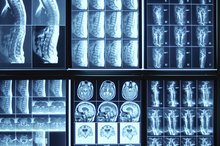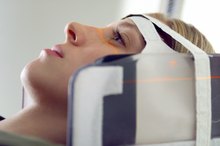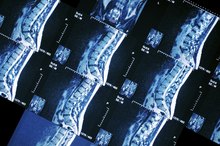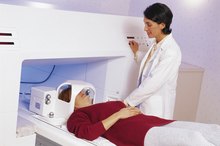What does fact checked mean?
At Healthfully, we strive to deliver objective content that is accurate and up-to-date. Our team periodically reviews articles in order to ensure content quality. The sources cited below consist of evidence from peer-reviewed journals, prominent medical organizations, academic associations, and government data.
The information contained on this site is for informational purposes only, and should not be used as a substitute for the advice of a professional health care provider. Please check with the appropriate physician regarding health questions and concerns. Although we strive to deliver accurate and up-to-date information, no guarantee to that effect is made.
Pros & Cons of X-Rays
Seven out of 10 people receive either a medical or dental X-ray every year, according to the Environmental Protection Agency, making X-rays the primary source of man-made radiation exposure. Thousands of X-ray machines are used every day in medical settings.
Function
X-ray machines work by sending out tiny X-ray particles, called photons, through the body and capturing them on special film or a computer. The X-ray particles are the same kind of radiation as sunlight and travel through the body in the same way.
Because photons move easily through substances like air, these show up as black on the X-ray film. Fluids in the body show up as gray, because the photons can partially penetrate liquid. The photons cannot penetrate very dense matter, such as bones and teeth, and these substances show up on the X-ray film as white.
X-ray examinations are given by trained medical professionals, called radiologists, in a medical setting.
- X-ray machines work by sending out tiny X-ray particles, called photons, through the body and capturing them on special film or a computer.
- The X-ray particles are the same kind of radiation as sunlight and travel through the body in the same way.
Pros
Advantages & Disadvantages of X-Rays
Learn More
X-rays are a useful diagnostic tool because they can provide a clear picture of many internal structures that could only be viewed through more complex or intrusive methods without X-rays.
X-rays can illuminate the skeletal system to diagnose broken bones or joint damage. They also can confirm the existence of suspected bodily blockages, such as kidney stones or gallstones, that might need medical intervention.
Because they are quick and easily performed tests, X-rays are good for situations, such as emergency room visits, where speed is important.
- X-rays are a useful diagnostic tool because they can provide a clear picture of many internal structures that could only be viewed through more complex or intrusive methods without X-rays.
- They also can confirm the existence of suspected bodily blockages, such as kidney stones or gallstones, that might need medical intervention.
Cons
X-rays have the potential to cause cellular damage because they are ionizing rays and may remove electrons from the atoms with which they come in contact. Though the risk is small, it is possible that this cellular damage could lead to cancer. In some rare cases, this damage can affect ovary cells or sperm cells, making a person infertile.
X-rays are potentially dangerous for very small children. They have the potential to cause birth defects in unborn children.
- X-rays have the potential to cause cellular damage because they are ionizing rays and may remove electrons from the atoms with which they come in contact.
- In some rare cases, this damage can affect ovary cells or sperm cells, making a person infertile.
Considerations
Advantages & Disadvantages of a CAT Scan
Learn More
The National Academy of Sciences has said that in most cases, the benefits of diagnosis outweigh the possible risks of using X-rays 1. To ensure your safety, choose trained professionals at recognized medical institutions to perform your X-rays and carefully follow the instructions given to you during the procedure.
Be sure to tell your doctor if you are pregnant, trying to become pregnant or breastfeeding before your X-ray exam.
If you have questions about X-ray safety, talk with your doctor or health care provider.
- The National Academy of Sciences has said that in most cases, the benefits of diagnosis outweigh the possible risks of using X-rays 1.
- If you have questions about X-ray safety, talk with your doctor or health care provider.
Regulations
X-ray use is regulated by several different agencies in the United States. Individual states work with the Food and Drug Administration to inspect and approve the X-ray machines used within their borders. The FDA regulates the production of X-ray machinery. The National Institute of Standards and Technology is responsible for setting the standards for X-ray use and manufacture.
- X-ray use is regulated by several different agencies in the United States.
- Individual states work with the Food and Drug Administration to inspect and approve the X-ray machines used within their borders.
Related Articles
References
- ADA: Benefits of X-Rays
- Medline: X-Rays
- U.S. National Library of Medicine MedlinePlus. X-rays. Updated March 4, 2016.
- U.S. Food & Drug Administration. Medical x-ray imaging. Updated June 14, 2019.
- RadiologyInfo.org. Contrast materials. Updated July 23, 2018.
- U.S. Food & Drug Administration. X-Rays, pregnancy and you. Updated December, 9, 2017.
- RadiologyInfo.org. X-ray (radiography).
- American Cancer Society. Mammogram basics. Updated October 3, 2019.
- American Cancer Society. Mammogram Basics. Updated Oct 9, 2017.
- Chandra X-Ray Center. (n.d.). Where Does the "X" in "X-ray" Come From?.
- High Energy Astrophysics Science Archive Research Center. (2014). The Electromagnetic Spectrum.
- Johns Hopkins Medicine. What Are X-rays?.
- Mayo Clinic. Is It Safe to Have an X-ray During Pregnancy? Updated Feb 16, 2018.
- Radiological Society of North America. Contrast Materials. Updated July 23,2018.
- U.S. Food and Drug Administration. Medical X-ray Imaging. Updated May 2, 2018.
Writer Bio
Holly Roberts is an award-winning health and fitness writer whose work has appeared in health, lifestyle and fitness magazines. Roberts has also worked as an editor for health association publications and medical journals. She has been a professional writer for more than 10 years and holds a B.A. in English and an M.A. in literature.








